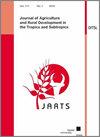Determinants of protected tomato production technologies among smallholder peri-urban producers in Kiambu, Kenya
Q3 Social Sciences
Journal of Agriculture and Rural Development in the Tropics and Subtropics
Pub Date : 2021-03-05
DOI:10.17170/KOBRA-202102113203
引用次数: 2
Abstract
Climate variability and the rise in incidences of pests and diseases continue to undermine production of high value vegetables among smallholder farmers in sub-Saharan Africa. In order to respond to these challenges, protected farming technologies (PFT) (such as greenhouses) which modify the plant environment and therefore aid in avoiding the harmful eects of climatic factors have been promoted. Greenhouses protect the crops against high solar radiation and heavy rainfall that have the potential of destroying vulnerable crops like tomatoes. Consequently, PFT is associated with better yields and farm incomes. However, the adoption of PFT among smallholder farmers, not least in Kenya is low. Drawing on the Agricultural Household Model (AHM) theoretic framework, this paper assessed the determinants of adoption of PFT among smallholder tomato farmers in Kenya. Tomato is the second most important horticultural vegetable crop in Kenya after potatoes in terms of production volumes and value. Data for the study were collected from a cross sectional multistage random survey of 104 tomato farming households and analysed using maximum likelihood probit model. The probit results revealed that the age of a farmer, educational level, household size, total household income and access to credit positively influenced the likelihood of PFT adoption. The likelihood of adoption was negatively related to distance to input markets and access to the county government extension services. Overall, the results of this study suggest that an integrated promotional strategy that accounts for household heterogeneities and focuses on institutional arrangements that support the accumulation of human and financial capital would enhance PFT adoption.肯尼亚Kiambu城市周边小农户番茄保护生产技术的决定因素
气候变化和病虫害发病率的上升继续破坏撒哈拉以南非洲小农的高价值蔬菜生产。为了应对这些挑战,保护农业技术(PFT)(如温室)已经得到推广,这些技术可以改变植物环境,从而有助于避免气候因素的有害影响。温室保护作物免受高太阳辐射和强降雨的影响,这些辐射和强降雨有可能摧毁西红柿等脆弱的作物。因此,PFT与更好的产量和农业收入有关。然而,在小农户中,尤其是在肯尼亚,PFT的采用率很低。本文利用农户模型(AHM)理论框架,评估了肯尼亚番茄小农采用PFT的决定因素。就产量和价值而言,番茄是肯尼亚仅次于土豆的第二大园艺蔬菜作物。本研究的数据收集自104个番茄种植户的横断面多阶段随机调查,并使用最大似然概率模型进行分析。probit结果显示,农民的年龄、受教育程度、家庭规模、家庭总收入和获得信贷的机会对采用PFT的可能性有积极影响。采用的可能性与投入市场的距离和获得县政府推广服务的机会呈负相关。总体而言,本研究的结果表明,考虑到家庭异质性并侧重于支持人力和金融资本积累的制度安排的综合推广策略将促进PFT的采用。
本文章由计算机程序翻译,如有差异,请以英文原文为准。
求助全文
约1分钟内获得全文
求助全文
来源期刊
CiteScore
2.30
自引率
0.00%
发文量
0
审稿时长
>36 weeks
期刊介绍:
The Journal of Agriculture and Rural Development in the Tropics and Subtropics publishes papers dealing with original research and review papers in the fields of plant production, animal nutrition and animal husbandry, soil science, rural economy and farm management, forestry and forest economy, veterinary hygiene and protection against epidemics.

 求助内容:
求助内容: 应助结果提醒方式:
应助结果提醒方式:


